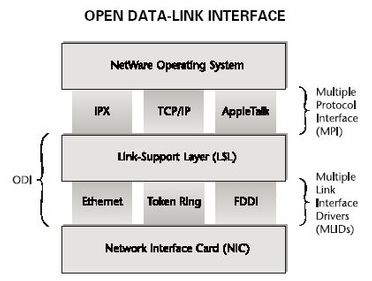Open Data-link Interface (ODI)
The Open Data-Link Interface (ODI), developed by Apple and Novell, serves the same function as Microsoft and 3COM's Network Driver Interface Specification (NDIS). Originally, ODI was written for NetWare and Macintosh environments. Like NDIS, ODI provides rules that establish a vendor-neutral interface between the protocol stack and the adapter driver.
Open Data-link Interface (ODI) allows multiple NICs to be bound to multiple protocols, similar to the network driver interface specification (NDIS) standard. ODI is a legacy standard that was defined primarily for the Internetwork Packet Exchange (IPX) protocol on Novell NetWare 2. x and 3. x networks. It resides in Layer 2, the Data Link layer, of the OSI model. This interface also enables one or more network drivers to support one or more protocol stacks.
Microsoft’s NWLink IPX/SPX-Compatible Transport supports ODI for backward compatibility.
ODI consists of several discrete components:
- Multiple Link Interface: The interface to which device drivers for the NIC are attached
- Link Support Layer: Provides a link for drivers, directing network traffic from the drivers to the proper protocol
- Multiple Protocol Interface: Provides an interface for the connection of protocol stacks such as TCP/IP, IPX, and AppleTalk. When a packet arrives at a NIC, it is processed by the card’s driver and passed to the Link Support Layer, where it is handed off to the appropriate protocol stack. The packet passes up through the protocol stack for higher-level processing before being transmitted over the network to its proper destination.
With ODI, a single workstation can transparently communicate with several different protocol stacks, using just one LAN driver and LAN board. Using ODI, a workstation can access several protocol-specific applications and services concurrently. For example, from a single workstation, a user can access TCP/IP-specific services like Telnet while being logged into a NetWare server over IPX. ODI also allows communication between devices with different frame formats. For example, a single workstation can communicate with any device using one of the four Ethernet frame types.
Like NDIS, the NetWare ODI driver interface standardizes the development of NIC drivers so that vendors do not have to be concerned with writing separate drivers to work with each of the different network protocols.
See Also
References

